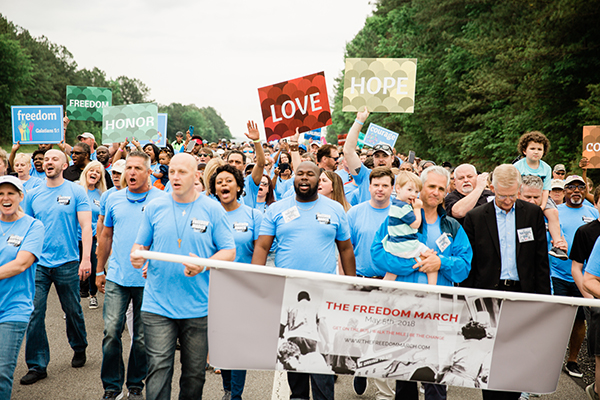By Grace Thornton
The Alabama Baptist
Every day for months Jacqueline Paddio drove back and forth to work down Highway 202 from Anniston to Word Alive International Outreach in Oxford, where she serves on staff.
And every day as she passed the historical markers posted on the road, she had questions weighing heavy on her heart.
“Not being from here, I didn’t know the whole history of what had happened,” Paddio said.
But she knew she needed to know.
So she asked around and heard the story — the story of the Greyhound Bus that left Atlanta on May 14, 1961, taking on board seven members of the Freedom Riders, a group of people on a journey to test interstate bus segregation. When they got to the bus station in Anniston, a mob met them, slashed the bus’s tires and broke the windows.
And when the bus driver stopped a little bit down the road to change the tire, the mob caught up with them, set the bus on fire and attacked the passengers.
“As I heard the story and thought about it, I just kept hearing God say we needed healing, reconciliation and restoration here,” Paddio said.
She began to take that idea to others. She talked with her pastor, Kent Mattox. She met with a local Freedom Riders association that was already looking for ways to bring the community together.
And she met with Roland Brown, pastor of Golden Springs Baptist Church, Anniston, in Calhoun Baptist Association.
For more than 10 years, Brown had been working hard to reach across lines and love people wherever they are, he said. When Anniston held hearings a few years back to talk about making the bus burning site a national monument, Brown went to show his support.
And when Paddio said she wanted to do a re-enactment of the freedom ride, Brown said he wanted to be on that bus.
“Our church is one that wants to love others, to be neighbors,” Brown said. “And if I can do something about reconciliation and I don’t, then I’m responsible.”
So he was there May 5 when the buses pulled out for the Freedom March event — along with several hundred other people who gathered. The group boarded buses at Word Alive, then they retraced the route of the Freedom Riders’ bus starting at the Greyhound Station.
“They had set up little mile markers and encouraged us to pray along the way,” Brown said. “It was emotional. The whole ride was a spiritual journey toward hope. I can’t even begin to tell you how it touched my soul.”
He sat in the back of the bus because he wanted to know what that felt like. He made friends along the way.
Then the buses stopped about a mile from the bus burning site.
“We stopped there, then walked and prayed and sang until we got to the place (the site of the bus burning),” Brown said. Even though it was called the Freedom March, “it was more of a time of prayer for reconciliation and redemption than it was a march.”
Byron Jackson, pastor of Greater Thankful Missionary Baptist Church, Anniston, said it was “breathtaking” to look back down the hill behind him at the united group walking up Highway 202.
“There were so many people from different locations and backgrounds coming together for the same purpose,” he said. “It was powerful to see how all of us could come together. It was beautiful.”
Jackson said the day was “an amazing event.”
“It was a great opportunity for me to connect with white pastors in the area because prior to us coming together for the work of this event, there hadn’t been much work done across the racial barrier,” he said.
But now he, Brown and others are good friends.
Working together
“Mine and Roland’s relationship started before this, but we were able to learn how to work together and how to lead the people we pastor to work together,” Jackson said. “He’s been a great addition to my life and the march event brought us closer.”
Eric Snider, pastor of First Baptist Church, White Plains, in Anniston, said he got involved in the march because he wanted to do more than just preach about racial reconciliation.
“I wanted to make it more than an academic lesson,” he said. “The march was a healing experience. It was really something special.”
Not just that — it reminded him of the time when all racial strife will ultimately be healed, Snider said. “In a bunch of ways, it was kind of like heaven — when every tribe, language and people will come together.”
To learn more about the event, visit thefreedommarch.org.






Share with others: